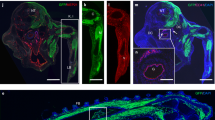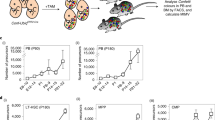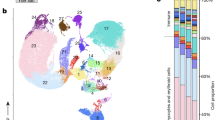Abstract
DURING the fetal stage of development, the human erythroid cells synthesise mainly fetal haemoglobin (α2γ2) but switch to almost exclusive formation of adult haemoglobin (α2β2) soon after birth. Similar ontogenetic changes in the activity of the closely linked γ- and β-genes are seen in most primates and few other mammals. In goats and sheep over 95% of the haemoglobin synthesised in the fetus is of the fetal type; the switch from fetal to adult haemoglobin formation starts at about 130 gestational days and is completed within a few weeks1. Several hypotheses have been formulated to account for these striking changes in haemoglobin gene activity during ontogeny, but the factors responsible for haemoglobin switching in vivo remain unknown. We report here an experiment which shows that the fetal haematopoietic cells readily switch to adult haemoglobin formation once transplanted to an adult animal. Our findings provide evidence that the switch from fetal to adult haemoglobin formation is not restricted to the perinatal developmental stage, and raise the possibility that the haematopoietic microenvironment determines the programme of haemoglobin formation in the haematopoietic progenitor cells of the fetus or the adult animal.
This is a preview of subscription content, access via your institution
Access options
Subscribe to this journal
Receive 51 print issues and online access
$199.00 per year
only $3.90 per issue
Buy this article
- Purchase on Springer Link
- Instant access to full article PDF
Prices may be subject to local taxes which are calculated during checkout
Similar content being viewed by others
References
Wood, W. G. et al. Nature 264, 799–801 (1976).
Blunt, M. H. & Huisman, T. H. J. in The Blood of Sheep; Composition and Function, 155–180 (Springer, New York, 1975).
Suzuki, T., Benesch, R. E., Yung, S. & Benesch, R. Analyt. Biochem. 55, 249–254 (1973).
Alter, B. P., Rappeport, J. H., Huisman, T. H. J., Schroeder, W. A. & Nathan, D. G. Blood 48, 843–853 (1976).
Papayannopoulou, Th. & Stamatoyannopoulos, G. in Cellular and Molecular Regulation of Hemoglobin Switching (eds Stamatoyannopoulos, G. & Nienhuis, A. W.) 73–83 (Grune and Stratton, New York, 1979).
Zanjani, E. D. et al. in Cellular and Molecular Regulation of Hemoglobin Switching (eds Stamatoyannopoulos, G. & Nienhuis, A. W.) 169–177 (Grune and Stratton, New York, 1979).
Author information
Authors and Affiliations
Rights and permissions
About this article
Cite this article
ZANJANI, E., MCGLAVE, P., BHAKTHAVATHSALAN, A. et al. Sheep fetal haematopoietic cells produce adult haemoglobin when transplanted in the adult animal. Nature 280, 495–496 (1979). https://doi.org/10.1038/280495a0
Received:
Accepted:
Published:
Issue Date:
DOI: https://doi.org/10.1038/280495a0
This article is cited by
-
Human erythroid cells produced ex vivo at large scale differentiate into red blood cells in vivo
Nature Biotechnology (2002)
-
Control of haemoglobin switching by a developmental clock?
Nature (1985)
-
Adult haematopoietic cells transplanted to sheep fetuses continue to produce adult globins
Nature (1982)
-
Hemoglobin switching in the salamanderPleurodeles waltlii
Wilhelm Roux's Archives of Developmental Biology (1982)
-
Fetal antigen expressed on mouse erythrocytes is programmed at the early precursor stage in fetal liver
Nature (1981)
Comments
By submitting a comment you agree to abide by our Terms and Community Guidelines. If you find something abusive or that does not comply with our terms or guidelines please flag it as inappropriate.



